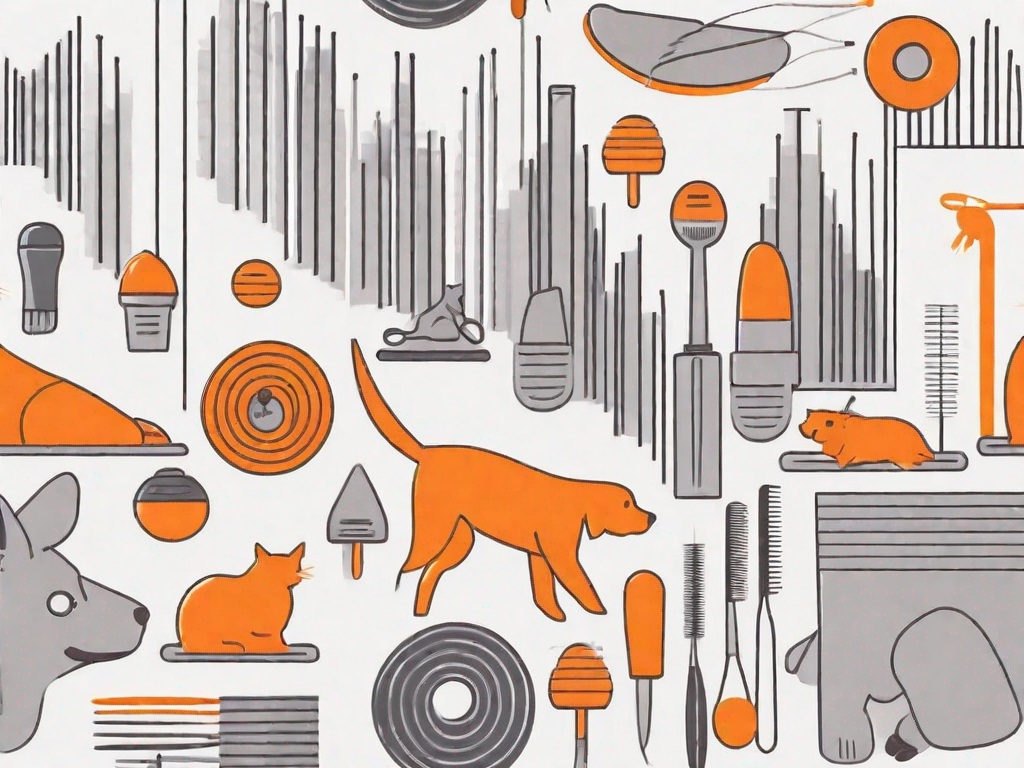.svg)
Creating a Growth Strategy Template for Pet Products
.svg)

Introduction: Welcome to the world of pet products, where the demand is high and competition is fierce. In order to thrive in this market, it is crucial for your business to have a growth strategy in place. By understanding the importance of a growth strategy and analysing the pet products market, you can define your business goals, develop a unique selling proposition (USP), and ultimately craft a growth strategy template that will set you apart from the competition. In this article, we will dive into the key components of creating a growth strategy template for your pet products business.
Understanding the Importance of a Growth Strategy
Before we delve into the specifics of creating a growth strategy template, let's first understand why it is essential for your pet product business. A growth strategy serves as a roadmap, guiding your business towards success and expansion. It outlines the actions and initiatives that need to be undertaken to achieve long-term growth.
When it comes to the pet products industry, having a growth strategy is crucial. The pet industry is a thriving market, with pet owners constantly seeking new and innovative products to enhance the well-being of their beloved furry friends. Without a growth strategy, your business may struggle to adapt to market changes, customer preferences, and emerging trends.
By having a well-defined growth strategy, you can stay ahead of the curve and ensure the long-term sustainability of your business. It enables you to identify potential areas for growth and take proactive steps to capitalize on them. Whether it's expanding your product line, targeting new customer segments, or exploring new distribution channels, a growth strategy provides the framework for making informed decisions that will drive your business forward.
Why Your Pet Product Business Needs a Growth Strategy
Every business, including those in the pet products industry, needs a growth strategy to stay competitive and relevant. The pet industry is a dynamic and ever-evolving market, with new trends, technologies, and consumer demands constantly emerging. Without a growth strategy, your business may find it challenging to keep up with these changes and may risk falling behind your competitors.
Having a growth strategy is like having a compass that guides your business through uncertain times. It helps you identify potential risks and opportunities, allowing you to navigate through challenges and make strategic decisions that will propel your business forward. A growth strategy also provides a sense of direction and purpose for your team, aligning everyone towards a common goal and motivating them to work towards its achievement.
The Role of a Growth Strategy in Business Success
A growth strategy plays a crucial role in the success of your pet product business. It provides a clear direction and focus, helping you allocate resources effectively and make informed business decisions. With a growth strategy in place, you can prioritize your efforts and investments, ensuring that they align with your long-term goals and objectives.
Moreover, a growth strategy enables you to identify and capitalize on untapped market opportunities. By conducting thorough market research and analysis, you can uncover niche segments or unmet customer needs that present significant growth potential. Armed with this knowledge, you can develop tailored products or services that cater to these specific market segments, giving your business a competitive edge and driving growth.
Furthermore, a growth strategy allows you to enhance customer satisfaction and expand your customer base. By understanding your target audience and their evolving needs, you can develop strategies to attract and retain customers. This may involve improving product quality, providing exceptional customer service, or implementing loyalty programs. By focusing on customer satisfaction, you can build a loyal customer base that will not only drive repeat business but also serve as brand advocates, spreading positive word-of-mouth and attracting new customers.
Analysing the Pet Products Market
Before you can develop an effective growth strategy, it is important to gain a deep understanding of the pet products market. This involves identifying your target audience and staying informed about market trends and opportunities.
The pet products market is a thriving industry that caters to the needs and desires of pet owners around the world. From food and toys to grooming and healthcare products, there is a wide range of offerings available to meet the diverse needs of pets and their owners.
Identifying your target audience in the pet products market is paramount for the success of your business. As a business owner, you need to determine the demographic and psychographic characteristics of your customers. Are you targeting pet owners of a specific age group, income level, or geographic location? Understanding your target audience will help you tailor your marketing efforts and product offerings to meet their specific needs and preferences.
For example, if you are targeting pet owners in urban areas, you may want to focus on products that are convenient and easy to use in smaller living spaces. On the other hand, if your target audience consists of pet owners in rural areas, you may want to offer products that are more durable and suitable for outdoor use.
Understanding market trends and opportunities is crucial for staying competitive in the pet products market. The pet industry is constantly evolving, with new trends and innovations emerging all the time. By staying updated on the latest market research, consumer behavior, and emerging trends in pet care, you can identify gaps in the market and adapt your products or services accordingly.
One emerging trend in the pet products market is the increasing demand for organic and natural products. Pet owners are becoming more conscious about the health and well-being of their furry friends, and are seeking products that are free from artificial ingredients and chemicals. By offering a range of organic and natural pet products, you can tap into this growing market and attract environmentally conscious pet owners.
Another opportunity for growth in the pet products market lies in the area of personalized products and services. Pet owners are increasingly looking for unique and customized options to pamper their pets. By offering personalized pet accessories, such as engraved tags or custom-made collars, you can cater to this demand and differentiate yourself from competitors.
In conclusion, analysing the pet products market is a crucial step in developing an effective growth strategy. By identifying your target audience and staying informed about market trends and opportunities, you can tailor your marketing efforts and product offerings to meet the specific needs and preferences of pet owners. With a deep understanding of the market, you can position your business for success in the thriving pet products industry.
Defining Your Business Goals and Objectives
With a solid understanding of the pet products market, it's time to define your business goals and objectives. Setting SMART (Specific, Measurable, Achievable, Relevant, and Time-bound) goals will help you stay focused and track your progress effectively.
When it comes to running a successful pet product business, having clear goals and objectives is crucial. These goals serve as a roadmap, guiding you towards success and helping you stay on track. Without well-defined goals, it's easy to lose sight of what you want to achieve and get lost in the vast sea of possibilities.
So, how do you go about setting these goals? One effective approach is to use the SMART framework. This framework ensures that your goals are specific, measurable, achievable, relevant, and time-bound.
Setting SMART Goals for Your Pet Product Business
When setting goals for your pet product business, it's important to be as specific as possible. Instead of simply saying "increase sales," set a target of "increasing sales by 10% within the next six months." This specific goal gives you a clear target to work towards and allows you to assess your success accurately.
Measurability is another key aspect of setting SMART goals. By having measurable goals, you can track your progress and make necessary adjustments along the way. This could involve regularly reviewing sales figures, monitoring customer feedback, or analyzing website traffic to gauge the effectiveness of your strategies.
Achievability is also a vital factor to consider when setting goals. While it's important to aim high, it's equally important to set goals that are within reach. Setting unrealistic goals can lead to frustration and demotivation. By setting achievable goals, you can maintain a sense of momentum and keep moving forward.
Relevance is another crucial aspect of goal setting. Your goals should align with your overall business objectives and reflect the needs and desires of your target audience. For example, if you've identified a niche within the pet products market, your goals should be tailored to cater to that specific audience.
Lastly, time-bound goals provide a sense of urgency and help you stay focused. By setting deadlines for your goals, you create a sense of accountability and ensure that progress is being made. This time-bound aspect also allows you to break down larger goals into smaller, manageable milestones.
Aligning Your Business Objectives with Market Opportunities
As you define your business objectives, it's essential to take into account the market opportunities that you have identified earlier. These opportunities could be emerging trends, untapped niches, or new product categories that have the potential to drive growth.
By aligning your business objectives with the market opportunities, you ensure that your growth strategy is well-aligned with the needs and demands of your target audience. This alignment increases the chances of success and helps you stay ahead of the competition.
For example, if you've identified a growing demand for organic pet products, you could set a business objective to develop a range of organic pet food and accessories. By capitalizing on this market opportunity, you position your business as a leader in the organic pet product space and cater to the increasing number of pet owners seeking healthier options for their furry friends.
Furthermore, exploring new product categories or services can also be a valuable business objective. Conducting thorough market research and identifying gaps in the market can present opportunities for diversification and expansion. By adding complementary products or services to your existing offerings, you can attract a broader customer base and increase revenue streams.
Remember, the key to success lies in understanding the market and aligning your business objectives accordingly. By seizing the identified market opportunities and setting SMART goals, you can steer your pet product business towards growth and profitability.
Developing a Unique Selling Proposition (USP)
A strong USP is essential in differentiating your pet products from competitors and capturing the attention of your target audience. It should highlight the unique features, benefits, or values that set your products apart from the rest.
Differentiating Your Pet Products from Competitors
Take a look at your competitors and identify what sets them apart. Then, determine how your pet products can offer something unique or better. This could be through superior quality, innovative design, eco-friendly materials, or exceptional customer service. Develop a compelling USP that clearly communicates why customers should choose your products over others.
Creating a Strong Brand Identity for Your Pet Products
Your brand identity plays a crucial role in establishing trust and loyalty among your customers. Invest time and effort in creating a strong brand identity that resonates with your target audience. This includes developing a memorable logo, choosing brand colours and fonts, and crafting a consistent brand voice across all communication channels.
Crafting Your Growth Strategy Template
Now that you have a solid foundation in place, it's time to craft your growth strategy template. This template will serve as a practical and actionable document that outlines the specific steps you will take to achieve your business goals.
Key Components of a Successful Growth Strategy Template
A successful growth strategy template should include the following components:
- An executive summary that outlines your overall growth strategy.
- Situational analysis, including a SWOT (Strengths, Weaknesses, Opportunities, Threats) analysis.
- Clear objectives and goals, as discussed earlier.
- Action plans with specific tasks, timelines, and responsible team members assigned to each.
- Financial projections and budgets to ensure resources are allocated appropriately.
- A monitoring and evaluation framework to track progress and make adjustments as needed.
Tailoring Your Growth Strategy to Your Pet Product Business
Remember, your growth strategy template should be tailored specifically to your pet product business. While there are general principles and frameworks to follow, it's essential to customize them to align with the unique needs, challenges, and opportunities of your business.
Conclusion
Creating a growth strategy template for your pet product business is a crucial step towards long-term success and sustainability. By understanding the importance of a growth strategy, analysing the pet products market, defining your business goals, developing a unique selling proposition, and crafting a tailored growth strategy template, you can position your business for significant growth and stand out in a competitive marketplace.
Remember, creating a growth strategy is an ongoing process. Monitor market dynamics, customer preferences, and industry trends regularly, and be prepared to adapt your strategy accordingly. By staying agile and responsive, you can continue to drive your pet product business forward and navigate the ever-evolving pet products market with confidence.
Let's
Let’s discuss how we can bring reinvigorated value and purpose to your brand.







.svg)